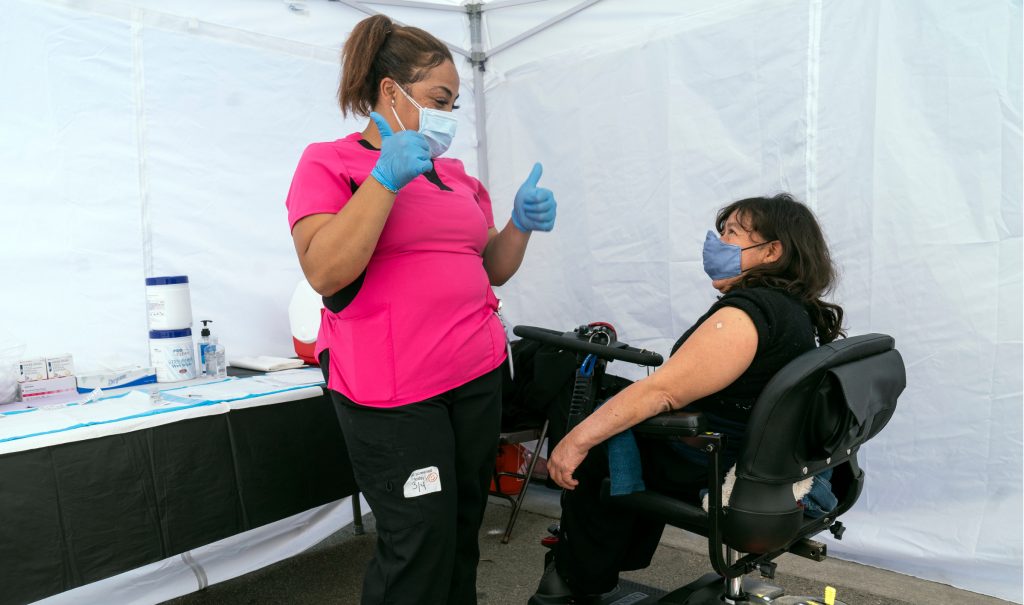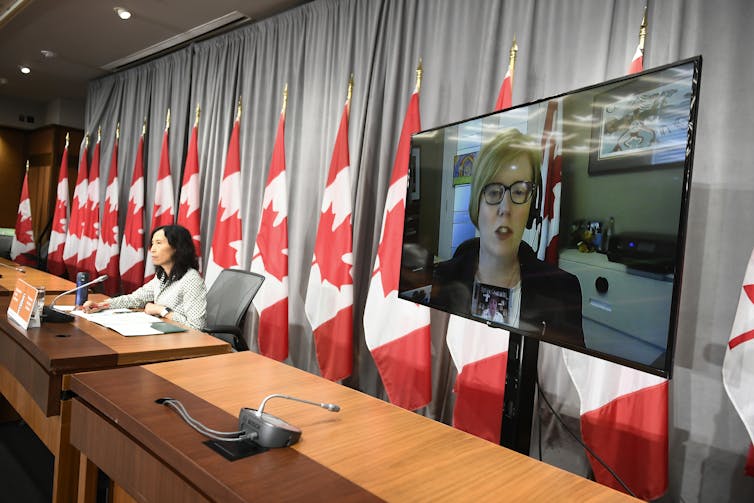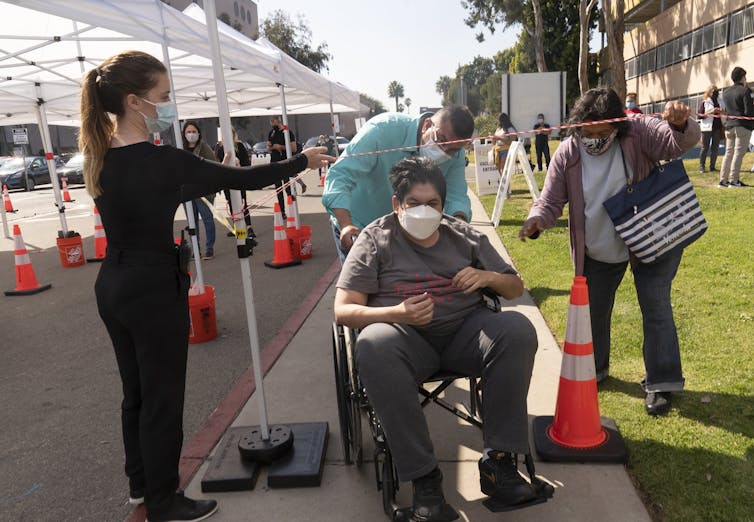COVID-19 amplifies the complexity of disability and race

Veronica Lopez, who has spina bifida, gets vaccinated at COVID-19 vaccination site at the East Los Angeles Civic Center in Los Angeles. (AP Photo/Damian Dovarganes)
BY Karen Kume Yoshida; Ann Fudge Schormans; Chavon Niles and Susan Mahipaul
April 8, 2021
By Karen Kume Yoshida, University of Toronto;
Ann Fudge Schormans, McMaster University;
Chavon Niles, University of Toronto,
and Susan Mahipaul, Western University
Ableism represents beliefs, social practices and policies that (re)produce and privilege expectations of able-bodiedness and able-mindedness. Resulting in the marginalization, exclusion and oppression of people with mind/body differences.
Disabled people’s identities are also intersectional — they may be racialized, gendered, elderly, may live in poverty and/or are part of newcomer communities. This viewpoint further reveals the persistent and invisible injustices disabled people experience and is important for developing policies, resources and supports for those affected by the pandemic.
The term intersectionality, coined by Black feminist legal scholar Kimberlé Crenshaw, illustrates how the systemic oppression Black women experience differs from that of Black men or white women because of the intertwining effects of various systems of oppression (such as racism, ableism, sexism, ageism and others).
An intersectional lens allows us to examine how peoples’ different social identities (race, ability, gender and age) are interconnected. How different contexts create privilege (circumstances of visibility, value, access to resources and opportunities for upward movement), and/or oppression (circumstances of invisibility, devaluation, lack of resources/access to them and limited opportunities).

Experiences and the intersectionality of disability
The following are stories our colleagues have shared with us.
Jeff Preston is a white man who has lived with disability all his life. He grew up with the support of his family, attended school and earned his PhD. He is now an assistant professor in Disability Studies at King’s University College at Western University in London, Ont. He uses an electric wheelchair and requires assistance from his attendants. This assistance allows him to get out of bed, get dressed and get to work.
“What has been important here is my day to day. My attendants and access to resources. On Day 1 of the pandemic one of my attendants resigned as they were heading home. Another one … now is not coming back, so I am down two attendants. If I lose another, I will be in a tight spot. How will I get out of bed? How can I work? What happens if I get sick?”
Preston is privileged as a white man and a university professor who was raised in a family with financial and social resources to support him and his education. He receives direct funding to hire attendants to support his daily activities, which the pandemic complicated.
Government mandates to stay at home and follow strict physical and social distancing guidelines assume that everyone can abide by them. For Preston, like other disabled persons, these mandates do not consider his need for attendants to get on with his daily life.
Jheanelle Anderson is a Black disabled immigrant woman with a congenital disability and autoimmune disease. When her family immigrated to Canada, she was left behind due to being labelled medically inadmissible under Canada’s ableist Immigration Act. After receiving surgery to amputate her leg, she was able to rejoin her family in Canada.
Her initial inadmissibility to Canada reflects the entanglement of racism and ableism to keep some bodies out. While Jheanelle feels that she had an easier transition than most immigrants given her familial support, the feeling of burden has stayed with her.
“I’m a disabled Black woman, you know, where all of that works in tandem with each other and it’s almost as if because like people are only focusing on a single story, I have to choose between either my Blackness or my disability. But I do not move in life like that. It is really important to highlight a holistic experience because … there are multiple things going on at the same time as I move through life. These structures are … very violent and they affect each and every one of my identities.”
As the realities of COVID-19 set in, Jheanelle was finishing up her master’s in social work and waiting to be refitted for a new prosthesis. Her new prothesis was put on hold as it was not deemed an essential service during the pandemic. Jheanelle’s story provides insight into the complexity of navigating health services. Most organizations focus services and programs on single identity issues, viewing disability as a monolithic experience without an understanding of the ongoing impact of racism and ableism embedded in these programs.
Her experiences as a service user during this pandemic cannot be broken apart and separated into “disabled,” “Black” and “woman” — they are intertwined.

Ableist assumptions and COVID-19
Ableist assumptions that everyone can abide by social and physical distancing mandates, or that health and support services can be put on hold without any consequences, create dangerous situations for disabled people.
Media reports have documented the negative impact of ableist pandemic policies on disabled people’s lives. Many face living in isolation to protect themselves and others, despite no longer having adequate supports related to personal care, food access, communication, etc.
Parents of disabled children coping with school closures are frustrated by the lack of resources for their children. And fear from parents with disabled children that ventilator shortages may mean their child’s ventilator will go to an abled-bodied person instead.
These stories demonstrate the devaluation of disabled lives. Yet they are just the tip of the iceberg.
While they are very important, the diversity within the disability community, the intersectional stories of disability, race and other social locations are not always presented. Disabled people, BIPOC, women, LGBTQ2S+ and other communities —all marginalized before the pandemic — are experiencing even greater inequities as a result of COVID-19. Pandemic planning has not taken them into consideration.
Using an intersectional approach will help bring visibility to diverse disability communities and provide the support they need to be safe, recover and rebuild their lives. Now, and going forward, we need to attend carefully and critically to the effects of the pandemic on diverse disability communities.![]()
Karen Kume Yoshida, Professor, Critical Disability Studies, University of Toronto; Ann Fudge Schormans, Associate Professor of Social Work, McMaster University; Chavon Niles, Postdoctoral Research Fellow, Department of Physical Therapy, Faculty of Medicine, University of Toronto, and Susan Mahipaul, Lecturer, Disability Studies at King’s University College, Western University
This article is republished from The Conversation under a Creative Commons license. Read the original article.


